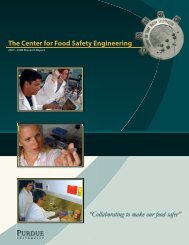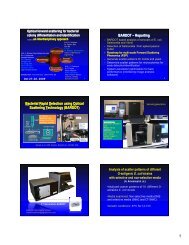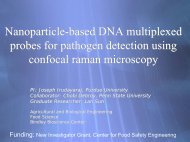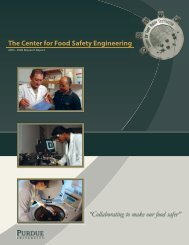Yiping He - Center for Food Safety Engineering
Yiping He - Center for Food Safety Engineering
Yiping He - Center for Food Safety Engineering
You also want an ePaper? Increase the reach of your titles
YUMPU automatically turns print PDFs into web optimized ePapers that Google loves.
Microarray analysis of quorum-sensing<br />
quorum sensing<br />
regulated gene expression in<br />
Campylobacter jejuni<br />
<strong>Yiping</strong> <strong>He</strong><br />
Microbial Biophysics and Residue Chemistry<br />
Research Unit<br />
Chin Chin-Yi Yi Chen<br />
Microbial <strong>Food</strong> <strong>Safety</strong> Research Unit<br />
Microaerobic workstation<br />
Optimal growth conditions <strong>for</strong> C. jejuni:<br />
5% O 2, 10%CO 2, 85% N 2, 82% relative humidity, 37 o C or 42 o C<br />
LuxS/AI-2 dependent quorum sensing<br />
• Quorum-sensing (QS) is a bacterial cell-to-cell<br />
communication process in response to high cell density<br />
• QS regulates gene expression by producing and<br />
releasing autoinducers (AIs)<br />
• Three major types of autoinducers: AI-1, AI-2, peptides<br />
• AI-2 is the product of the LuxS enzyme, which is widely<br />
conserved in bacteria<br />
• LuxS/AI-2 dependent QS controls a variety of cellular<br />
activities including the production of virulence factors<br />
and toxins, biofilm <strong>for</strong>mation, and swarming motility<br />
Campylobacter jejuni<br />
• A major cause of bacterial gastroenteritis and human diarrhea<br />
• A Gram-negative, microaerophilic, motile, spiral-shaped bacterium<br />
Some of the virulence factors in C. jejuni<br />
� Motility<br />
• An important factor <strong>for</strong> C. jejuni colonization in chicken<br />
• Alterations in flagellar gene expression affect its pathogenesity<br />
� Oxidative stress defense:<br />
• Highly sensitive to the O 2 metabolites/oxidative stress<br />
• Lacks the oxidative stress response factors: SoxR and OxyR<br />
• Utilizes: superoxide stress defense system (SodB)<br />
peroxide stress defense system (KatA, AhpC and Tpx)<br />
� Chemotaxis<br />
� Adhesion and invision<br />
� Toxin production<br />
� Iron acquisition<br />
� <strong>He</strong>at-shock response<br />
AI-2 biosynthesis and methyl cycle in E. coli<br />
MetF<br />
CH3-THF<br />
5, 10-methylene THF<br />
CH3-THPG<br />
???<br />
AI-2<br />
MetH, MetE<br />
THF, THPG<br />
DPD<br />
Homocysteine<br />
LuxS<br />
SRH<br />
Adenine<br />
Lsr<br />
LsrK P P<br />
P<br />
P<br />
LsrFG<br />
ATP ADP<br />
Methionine<br />
SahH<br />
Pfs<br />
Degraded AI-2<br />
2 μm<br />
SAM synthetase<br />
(MetK)<br />
SAM<br />
Methyltransferases<br />
SAH (toxic)<br />
11/27/2007<br />
1
Amino acid sequence alignment of LuxS<br />
E.coli MPLLDSFTVDHTRMEAPAVRVAKTMNTPHGDAITVFDLRFCVPNKEVMPERGIHTLEHLF 59<br />
S.typhimurium MPLLDSFAVDHTRMQAPAVRVAKTMNTPHGDAITVFDLRFCIPNKEVMPEKGIHTLEHLF 59<br />
V.harveyi MPLLDSFTVDHTRMNAPAVRVAKTMQTPKGDTITVFDLRFTAPNKDILSEKGIHTLEHLY 59<br />
H.influenzae MPLLDSFKVDHTKMNAPAVRIAKTMLTPKGDNITVFDLRFCIPNKEILSPKGIHTLEHLF 59<br />
C.jejuni MPLLDSFKVDHTKMPAPAVRLAKVMKTPKGDDISVFDLRFCIPNKDIMSEKGTHTLEHLF 60<br />
******* ****:* *****:**.* **:** *:****** ***:::. :* ******:<br />
EE.coli coli AGFMRNHLNGNGVEIIDISPMGCRTGFYMSLIGTPDEQRVADAWKAAMEDVLKVQDQNQI 119<br />
S.typhimurium AGFMRDHLNGNGVEIIDISPMGCRTGFYMSLIGTPDEQRVADAWKAAMADVLKVQDQNQI 119<br />
V.harveyi AGFMRNHLNGDSVEIIDISPMGCRTGFYMSLIGTPSEQQVADAWIAAMEDVLKVENQNKI 119<br />
H.influenzae AGFMRDHLNGDSIEIIDISPMGCRTGFYMSLIGTPNEQKVSEAWLASMQDVLGVQDQASI 119<br />
C.jejuni AGFMRDHLNSNSVEIIDISPMGCRTGFYMSLIGTPDEKSIAKAWEAAMKDVLSVSDQSKI 120<br />
*****:***.:.:**********************.*: ::.** *:* *** *.:* .*<br />
E.coli PELNVYQCGTYQMHSLQEAQDIARSILERDVRINSNEELALPKEKLQELHI- 170<br />
S.typhimurium PELNVYQCGTYQMHSLSEAQDIARHILERDVRVNSNKELALPKEKLQELHI- 170<br />
V.harveyi PELNEYQCGTAAMHSLDEAKQIAKNILEVGVAVNKNDELALPESMLRELRID 171<br />
H.influenzae PELNIYQCGSYTEHSLEDAHEIAKNVIARGIGVNKNEDLSLDNSLLK----- 166<br />
C.jejuni PELNIYQCGTCAMHSLDEAKQIAQKVLNLGISIINNKELKLENA-------- 164<br />
**** ****: ***.:*::**: :: .: : .*.:* * :<br />
LuxS-dependent AI-2 production<br />
Relativve<br />
light units<br />
1.0E+08<br />
1.0E+07<br />
1.0E+06<br />
1.0E+05<br />
1.0E+04<br />
1.0E+03<br />
1.0E+02<br />
1.0E+01<br />
0 2 4 6 8 10 12<br />
Assay Time (Hours)<br />
∆luxS<br />
WT<br />
MH broth<br />
• Wild-type C. jejuni produces functional AI-2<br />
• There is no AI-2 production in the luxS mutant<br />
• LuxS is a key enzyme in the AI-2 biosynthesis pathway<br />
Reduced motility in the ΔluxS mutant<br />
Halo diameter 35±1.22 mm 28±1.58 mm<br />
Construction of ΔluxS mutant in C. jejuni<br />
gatB<br />
luxS<br />
cj1199<br />
Primer 1 Primer 2 Primer 3 Primer 4<br />
Cm R<br />
Electroporate into C. jejuni<br />
Select <strong>for</strong> chloramphenicol-resistant clones<br />
First amplification<br />
Second amplification<br />
Restriction digest<br />
Ligation with Cm R cassette<br />
Verify mutant by PCR &<br />
sequencing<br />
Growth curves of the wt and ΔluxS mutant<br />
of C. jejuni<br />
Viable cell couunt<br />
(CFU/ml)<br />
1.0E+10<br />
1.0E+09<br />
1.0E+08<br />
1.0E+07<br />
1.0E+06<br />
1.0E+05<br />
doubling time:<br />
WT, 42°C<br />
∆ luxS, 42°C<br />
WT, 37°C<br />
∆ luxS, 37°C<br />
0 4 8 12 16 20 24 28 32<br />
Time (Hours)<br />
wild-type ΔluxS mutant<br />
37 o C 77 min 89 min<br />
42 o C 53 min 67 min<br />
Resistance of the wt and ΔluxS mutant<br />
to CHP and H 2O 2<br />
Diameter of growth innhibition<br />
zone (mm)<br />
50<br />
40<br />
30<br />
20<br />
10<br />
0<br />
3% 1% 0.33%<br />
CHP<br />
CHP: cumene hydroperoxide<br />
H 2O 2: hydrogen peroxide<br />
50<br />
40<br />
30<br />
20<br />
10<br />
0<br />
wt<br />
∆luxS<br />
3% 1% 0.33%<br />
H 2O2<br />
11/27/2007<br />
2
Expression microarray<br />
Oligo array<br />
Wild-type ΔluxS mutant<br />
Scanned microarray image<br />
In both H 2O 2 treated & untreated conditions:<br />
• Triplicates of cell samples and chips were used.<br />
• In each chip, there are triplicate sets of spotted oligos.<br />
• EEach h set t of f oligos li represents t >1600 ORF ORFs of f CC. jjejuni. j i<br />
• 9 replicate data was normalized and analyzed.<br />
• The up/down-regulated genes were selected by 1.5 fold<br />
cut-off combining with P value < 0.05.<br />
Differentially expressed genes in the ΔluxS<br />
Efflux<br />
ssystem stem<br />
ABC<br />
transporter<br />
PstABS<br />
MetF<br />
CH3-THF<br />
5, 10-methylene THF<br />
CH3-THPG<br />
AI-2<br />
MetE<br />
THF, THPG<br />
DPD<br />
Homocysteine<br />
LuxS<br />
SRH<br />
Adenine<br />
Methionine<br />
Pfs<br />
Oxidative stress<br />
response genes<br />
SAM synthetase<br />
(MetK)<br />
SAM<br />
Methyltransferases<br />
SAH (toxic)<br />
+H 2O 2<br />
Flagellar<br />
genes<br />
Expression microarray<br />
Oligo array<br />
H 2O 2 treated wild-type H 2O 2 treated ΔluxS mutant<br />
Selected genes regulated by luxS with/without H2O2 treatment<br />
Locus/Genes Gene product Fold change<br />
(wt/∆luxS)<br />
+ H2O2 - H2O2<br />
Cj1198 (luxS) S-ribosylhomocysteinase 331.6 195.5<br />
Cj1199 putative iron/ascorbate-dependent oxidoreductase 7.4 11.1<br />
Cj1200 putative periplasmic protein 2.2 3.2<br />
Cj1201(metE) homocysteine methyltransferase 1.66 0.95<br />
Cj1202(metF) 5,10-methylenetetrahydrofolate reductase 1.8 1.36<br />
Cj1096c(metK) S-adenosylmethionine synthetase 1.5 0.98<br />
Cj0613(pstS) possible periplasmic phosphate binding protein 2.1 2.9<br />
Cj0615(pstA) putative phosphate transport system permease protein 1.26 1.6<br />
Cj0616(pstB) phosphate ABC transporter, ATP-binding protein 1.9 2.1<br />
Cj0727 ABC transporter, periplasmic substrate-binding protein 2.1 1.57<br />
Cj0728 putative periplasmic protein 18 1.8 148 1.48<br />
Cj0301c(modB) molybdenum ABC transporter 2.0 1.12<br />
Cj1220(groES) co-chaperonin 1.69 1.27<br />
Cj0334(ahpC) alkyl hydroperoxide reductase 1.56 1.03<br />
Cj0779(tpx) probable thiol peroxidase 1.61 1.08<br />
Cj0117(pfs) S-adenosylhomocysteine nucleosidase 0.66 0.68<br />
Cj0697(flgG2) putative flagellar basal-body rod protein 0.46 0.84<br />
Cj0698(flgG) flagellar basal-body rod protein 0.51 0.70<br />
Cj0040 flagellar assembly protein 0.48 0.81<br />
Cj0041 hypothetical protein 0.52 0.70<br />
Cj0042(flgD) putative flagellar hook assembly protein 0.49 0.63<br />
Cj0043(flgE) flagellar hook protein 0.58 0.64<br />
Cj1031 putative outer membrane component of efflux system 0.76 0.74<br />
Cj1032 putative membrane fusion component of efflux system 0.57 0.87<br />
Cj1033 putative integral membrane component of efflux system 0.64 0.99<br />
Cj1034c possible dnaJ-like protein 0.61 0.71<br />
Real time RT-PCR verification of the<br />
microarray results<br />
Log2 of wt/ΔluuxS<br />
4<br />
2<br />
0<br />
-2<br />
cj1199<br />
cj1200<br />
metE<br />
metF<br />
pstB<br />
pstS<br />
cj0727<br />
cj0728<br />
aphC<br />
flgG2<br />
real-time PCR<br />
microarray<br />
flgG<br />
LuxS regulated genes<br />
cj0040<br />
cj0041<br />
cj1032<br />
cj1034<br />
11/27/2007<br />
3
Summary<br />
• In C. jejuni, AI-2 production is dependent on LuxS.<br />
• The ∆luxS mutant exhibits slightly slower growth, lower<br />
motility, and higher sensitivity to oxidative stress than<br />
those of the wt strain.<br />
• Microarray y analysis y revealed that AI-2/LuxS regulates g<br />
the expression of genes involved in AI-2 biosynthesis and<br />
methyl cycle, ABC transporter, membrane efflux system,<br />
stress responses, and cell motility.<br />
• Expression of the oxidative stress genes (ahpC and tpx)<br />
was lower in the ΔluxS mutant than that in the wt when<br />
the cells were treated with H2O2, supporting the<br />
observed higher sensitivity of the ∆luxS mutant to<br />
oxidative stress.<br />
Acknowledgements<br />
Bacterial Epidemiology &<br />
Antimicrobial Resistance<br />
ARS ARS-USDA, USDA, Athens, GA<br />
Jonathan G G. Frye, Frye Ph Ph.D. D<br />
Microarray Facility<br />
Fox Chase Cancer <strong>Center</strong><br />
Yuesheng Li, Ph.D.<br />
Microbial <strong>Food</strong> <strong>Safety</strong><br />
Terence Strobaugh<br />
Pina Fratamico, Ph.D.<br />
John Luchansky, Ph.D.<br />
Ph.D.<br />
Microbial Biophysics &<br />
Residue Chemistry<br />
Peter Irwin, Ph.D.<br />
George Paoli, Ph.D.<br />
Shu Shu-I I Tu, Ph. D.<br />
11/27/2007<br />
4












